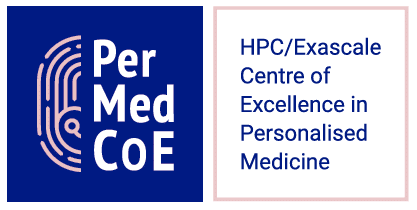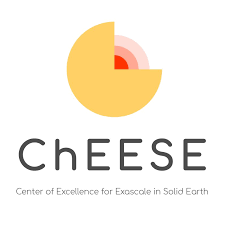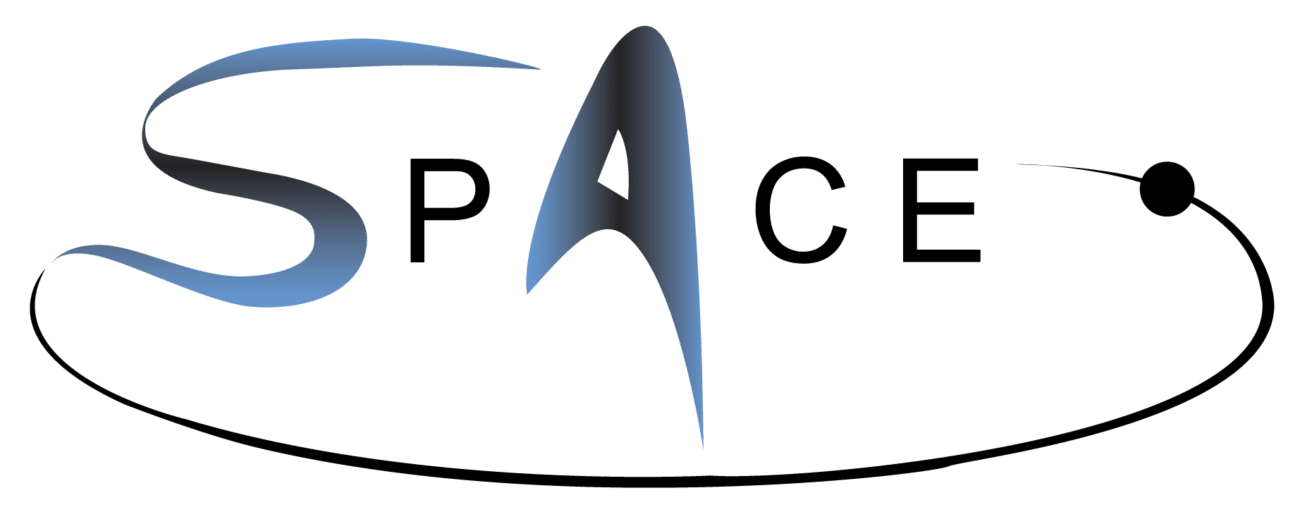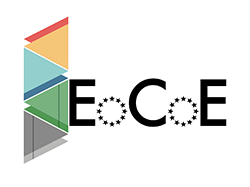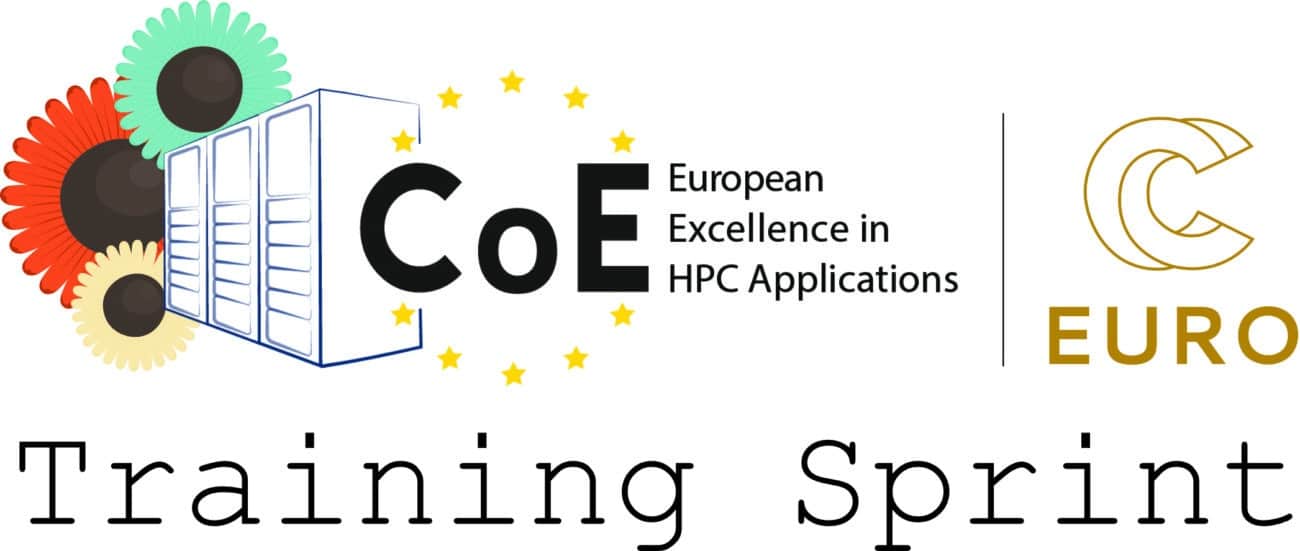
The EuroCC & CASTIEL2 “Training Sprint” initiative is designed to quickly disseminate the expertise and abilities of CoEs. These training events target individuals from academia and industry who stand to gain from high-performance computing.
November 17 – 21, 2025
MaX: SIESTA School
This course organized by MaX CoE, in collaboration with: BSC, Catalan Institute of Nanoscience and Nanotechnology (ICN2), the CECAM-IT-SIMUL node.
SIESTA is a multipurpose density-functional code able to perform efficient electronic structure calculations and ab initio molecular dynamics simulations of molecules and solids in fields that range from Geoscience, Biology, Nanoscience, Chemistry or Condensed Matter. It has become very popular worldwide, being used by thousands of researchers in both academia and industry. A very important feature is that its accuracy and cost can be tuned in a wide range, from quick exploratory calculations to highly accurate simulations matching the quality of other approaches, such as plane-wave methods, at a reduced computational cost. However, this flexibility can also represent a challenge for new users of the code, that need to get acquainted with a good number of specific nuts and bolts. The school is aimed at students and researchers from different disciplines in materials science who use, or plan to use, the SIESTA package. The students will learn its essential theoretical foundations, and to how to use the SIESTA code effectively (parallelization and new, more efficient, solvers). Pre- and post-processing tools will also be presented. More advanced features, such as the computation of quantum transport using the non-equilibrium Green’s function approach, will be introduced towards the end of the week.
June 9 – 13, 2025
MaX: School on Machine Learning for Molecules and Materials Research
This course organized by MaX CoE, in collaboration with: VINCA Institute, University of Belgrade, University of Modena and Reggio Emilia, Rudjer Boskovic Institute, SISSA and TU Delft
Machine learning and data-driven methods, combined with atomistic and molecular modeling, are transforming computational predictions with greater accuracy and informativeness. This shift is evident in the growing adoption of these methods across industries such as pharma, energy, and aerospace, as well as in the rise of start-ups leveraging AI for materials discovery.
To support researchers in integrating machine learning into their work, this school will introduce key methodologies through lectures and hands-on tutorials. Topics include machine learning-driven high-throughput searches, Bayesian optimization, generative models, large language models, interatomic potentials, excited state dynamics, coarse-grained models, and integrating experimental data.
June 2 – 5, 2025
MaX: Advanced SIESTA Workshop
This course organized by MaX CoE, in collaboration with: Catalan Institute of Nanoscience and Nanotechnology (ICN2), Consejo Superior de Investigaciones Científicas (CSIC)
This workshop will cover the key features of the Quantum ESPRESSO code, focusing on developing practical skills in atomistic modeling using density functional theory methods. Participants will gain hands-on experience in applying these methods, with a focus on practical applications. The aim is to equip participants with the skills needed to use Quantum ESPRESSO on modern HPC systems effectively in their research. SRCE will provide all participants with a computer for use during the workshop.
The unique advantages of the SIESTA method allow for the exploration of boundaries that are hard to be achieved by other DFT approaches. In this Workshop, we will showcase and discuss state-of-the-art research that relies on SIESTA and its interfaces with other computational tools.
Examples of these include the calculation of advanced magnetic properties (relying on TB2J), thermal conductivity (via TDEP), electrochemical processes (via SIESTA’s own QM/MM interface), potential energy surface explorations (with SIESTA/LUA) and electron-phonon coupling phenomena (with the elph interface). The usage of SIESTA in exascale and pre-exascale systems will be discussed, covering different technologies available for the calculation of electronic properties with tens of thousands of atoms. We will also include a discussion on how machine learning technologies intertwine with SIESTA, be it as a means to accelerate and improve calculations, or to use SIESTA as a provider for training data in other neural network approaches.
In this 3-day workshop, experts on the different topics will showcase current advances on their respective areas while also providing guidelines and opening the discussion for new approaches and ideas. A few selected sessions will also include short hands-on sections to further exemplify their capabilities.
May 19 – 23, 2025
MaX: Excited states in complex materials by MBPT methods
This course organized by MaX CoE, in collaboration with: CINECA, Psi-K, and the CECAM-IT-SIMUL node, University of Modena and Reggio Emilia, Modena (Italy), co-located with the CNR-NANO S3 Centre.
This school is designed for researchers interested in advanced computational methods for studying light-matter interactions, crucial for optoelectronic devices, quantum computing, and energy applications. Participants will receive introductory and advanced lectures on MBPT, covering topics such as the GW approximation, Bethe-Salpeter equation, non-linear optics, and recent algorithmic advances for 2D systems and metals. Hands-on sessions will focus on practical simulations using the YAMBO code within a high-performance computing (HPC) environment, including GPU-accelerated machines. Additionally, participants will learn Python-based post-processing and data analysis with YamboPy.
April 9 – 10, 2025
Exploring Biomolecular Modeling and Simulations
This course organized by BioExcel CoE, in collaboration with: NCC Turkey, ENCCS
This course provides an in-depth exploration of bioinformatics and computational approaches to predict and model biomolecular interactions at the atomic level. Participants will gain hands-on experience using the widely used HADDOCK software to model biomolecular complexes, combining molecular simulations, machine learning, and experimental data such as cryo-EM and small-angle scattering.
The course covers key topics, including integrative modeling, molecular dynamics (MD) simulations, and the setup of simulations using GROMACS. Additionally, participants will learn to build FAIR biomolecular simulation workflows with the BioExcel Building Blocks (BioBB) library, understand free energy calculations, and explore their application in drug design through protein-ligand binding predictions.
By the end of the course, participants will have a comprehensive understanding of biomolecular simulations, with practical skills in using the latest tools and methodologies for cutting-edge research in drug discovery and protein interaction modeling.
April 7 – 9, 2025
PIC (BIT1) modelling of the fusion plasma edge
This course organized by Plasma-PEPSC CoE, in collaboration with: NCC Czechia, NCC Slovenia, ENCCS, LECAD, Institute of Plasma Physics of the Czech Academy of Sciences (IPP CAS)
BIT1 is an electrostatic Particle in Cell (PIC) Monte Carlo (MC) code optimized for plasma edge modelling. It is 1D in usual and 3D in velocity space. Code is capable of simulating large scale systems with finest resolution in time and space.
During the meeting, we will introduce the BIT1 code, explain its modeling capabilities, and conduct training sessions for users of different levels. We will also consider examples of other PIC and MC codes and discuss future developments related to exascale and multi-dimensional versions of the code (BIT2, BIT3).
March 24 – 26, 2025
Containerization, CI/CD, and Benchmarking Solutions for HPC
This course organized by HiDALGO2 CoE, in collaboration with: NCC Czechia
In today’s fast-changing world of HPC and urban energy modeling, staying current is essential for researchers, developers, and policymakers. As part of CoE HiDALGO2, the Urban Building Pilot team is pleased to offer a three-day training session on Containerization, CI/CD, and Benchmarking Solutions for HPC.
During the course, you will learn how to create containers for HiDALGO2 codes and scientific HPC applications and implement CI/CD workflows using GitHub Actions, GitLab Runners, and JacamarCI. The course also covers setting up benchmarking pipelines with tools such as feelpp.benchmarking and reframe-hpc to evaluate and improve performance.
March 10 – 12, 2025
Data analytics for engineering data using machine learning
This course organized by EXCELLERAT-p2 CoE, in collaboration with: NCC Germany
This three-day online workshop addresses the preparation, analysis and interpretation of numerical simulation data by machine learning methods. Besides the introduction of the most important concepts like clustering, dimensionality reduction, visualization and prediction, this course provides several practical hands-on tutorials using the python libraries numpy, scikit-learn and pytorch as well as the SCAI DataViewer.
January 27, 2025
Extrae and Paraver: Profiling Weather and Climate Applications
This course organized by ESiWACE3 CoE, in collaboration with: NCC Austria
The National Competence Centre for HPC in Austria is organizing this one-day training together with ESiWACE3, the Centre of Excellence in simulation of weather and climate in Europe. With expertise in earth system modelling, software design, and high-performance computing, ESiWACE3 is supporting scientists on the path to exascale computing.
This course is about the BSC performance analysis tools, which are a set of different tools to support developers on the evaluation, tuning, and optimization of their codes. There are two main applications: Extrae, devoted to generate trace-files for a post-mortem analysis without modifying the source code, and Paraver, which is a flexible performance analyzer of the Extrae traces. They support different programming models such as C/C++, Fortran, Python, MPI, and OpenMP, as well as tracing of hardware counters, user functions, etc. In this course we will demonstrate the use of the tools in profiling weather and climate models, as an example, but they can be applied to any field of HPC.
The course consists of a theoretical part and hands-on labs for participants to practice how to analyze an Extrae trace with Paraver. We will use a climate application as a demonstration, focusing on typical problems arising to numerical models and computational fluid dynamic applications.
December 10, 2024
How European Projects Are Developing
HPC-Based Software and Services to Address Natural Hazards?
This course organized by ChEESE CoE, in collaboration with: NCC Spain
The workshop aims to showcase projects that leverage High-Performance Computing (HPC) to tackle natural hazards across Europe. This event will bring together experts from academia, research institutions, and industry to present innovative solutions and case studies.
Learning Outcomes: This workshop is an excellent opportunity for professionals, researchers, students, and policymakers interested in the application of HPC technologies to address natural hazards to gain insights and explore collaborative opportunities
November 12 – 13, 2024
MaX: Modeling of (nano)materials with Quantum ESPRESSO
This course organized by MaX CoE, in collaboration with: NCC Czech
This workshop will cover the key features of the Quantum ESPRESSO code, focusing on developing practical skills in atomistic modeling using density functional theory methods. Participants will gain hands-on experience in applying these methods, with a focus on practical applications. The aim is to equip participants with the skills needed to use Quantum ESPRESSO on modern HPC systems effectively in their research. SRCE will provide all participants with a computer for use during the workshop.
October 28 – 29, 2024
EXCELLERAT P2: Scientific Visualization using VISTLE and SENSEI
This course organized by EXCELLERAT P2 CoE , in collaboration with: NCC Germany
This course is targeted at researchers with basic knowledge in numerical simulation, who would like to learn how to visualize their simulation results on the desktop but also in Augmented Reality and Virtual Environments. The two-day workshop gives a short overview over scientific visualization in general, followed by a hands-on introduction to 3D desktop visualization with VISTLE (webpage on the EXCELLERAT P2 service portal) and COVISE, SENSEI. Participants will further learn how to build interactive 3D Models for Virtual Environments and how to set up an Augmented Reality visualization.
October 15, 2024
SPACE: RAMSES code for structure formation in the Universe
This series organized by SPACE CoE, in collaboration with: NCC Czechia, NCC Austria, UNITO, CNRS-CRAL, INAF, LMU, and UiO
The training is addressed to researchers working in the field of fluid dynamics as well as astrophysicists interested in structure formation in general. We will first present the main features of the RAMSE code, as well as its current scalability. We will then highlight the science than can be done with RAMSES using Tier0 resources. Last, we will discuss our work-plan to improve the performance of the code.
October 4, 2024
EESSI: Introduction to EESSI – European Environment for Scientific Software Installations
This event organized by EESSI CoE, in collaboration with: NCC Slovenia, NCC Austria together with MultiXscale CoE
Have you ever wished that all the scientific software you use was available on all the resources you had access to, without having to go through the pain of getting them installed the way you want/need?
The European Environment for Scientific Software Installations (EESSI – pronounced “easy”) is a common stack of scientific software for HPC systems and beyond, including laptops, personal workstations, and cloud infrastructure. In many ways it works like a streaming service for scientific software, instantly giving you the software you need, when you need it, and compiled to work efficiently for the architecture you have access to.
In this online workshop, we’ll explain what EESSI is, how it is being designed, how to get access to it, and how to use it. We’ll give a number of demonstrations and you can try EESSI out yourself on the Vienna Scientific Cluster (VSC).
September 23-25, 2024
SPACE: PLUTO Symposium 2024
This Symposium organized by SPACE CoE, in collaboration with: UNITO and INAF, Osservatorio Astronomico di Torino
The PLUTO symposium 2024 aims at bringing together developers, scientists and users with the purpose of sharing recent numerical algorithms, new code features as well as challenging astrophysical applications. A special focus will give to the GPU porting of the code and its forthcoming release. A hands-on session will also take place in order to help the new users to get used to the code structure. While we strongly encourage in-person participation, we will also ensure remote participation through the Webex application.
September 12 – 13, 2024
ESiWACE3: GPU optimization with Kernel Tuner
The National Competence Center for HPC in Austria is organizing this 2 half-day training together with ESiWACE3, the Centre of Excellence in simulation of weather and climate in Europe. With expertise in earth system modelling, software design, and high-performance computing, ESiWACE3 is supporting scientists on the path to exascale computing.
This training is about Kernel Tuner, a tool for automatic optimization of GPU code, developed by a team from ESiWACE3. As a new development, Kernel Tuner adds support for mixed precision and tuning accuracy, which comes in addition to the existing functionality of tuning parameters and code optimizations for compute performance and/or energy efficiency. The first day of the training will focus on getting to know the tool, where as the second day is all about (energy) efficient computing on GPUs.
September 4 – 6, 2024
POP3: Profiling and Optimisation Tools
The POP3 CoE, NCC Austria, NCC Czechia, NCC Hungary, NCC Poland, NCC Slovakia and NCC Slovenia are inviting you to the POP3 Profiling and Optimisation Tools Workshop.
This workshop focuses on tools and methodologies for performance analysis, debugging, and tuning through collaborative learning, particularly for teams working on similar codes.
The first day of the workshop introduces participants to the POP Centre of Excellence (CoE), detailing its services, methodology, and tools for performance assessments and second-level services. On the second day, the focus shifts to getting started with open-source multi-platform tools for analysing MPI+OpenMP application executions on CPU architectures. The third day delves into more advanced usage, including analysing application executions on combined CPU and GPU architectures. During this hands-on workshop, participants will be introduced to the use of Paraver/Extrae and Scalasca/Score-P/CUBE toolsets for CPUs and GPUs.
May 28 – July2, 2024
SPACE: PLUTO, OpenGadjet and ChanGa. Four Free online Training Events about Astrophysical and Cosmological Simulation Codes
This series organized by SPACE CoE, in collaboration with: UNITO, CNRS-CRAL, INAF, LMU, UiO and NCC Czechia
July 2
The ChaNGa code and the Charm++ framework
The training is addressed to researchers interested in HPC and the challenges that astrophysics codes present when scaling towards exa-scale. We will discuss both the benefits and difficulties of the ChaNGa code and the Charm++ framework. We will also discuss recent and future improvements of the code.
June 18
The OpenGadget code for Cosmological Simulations
The training is addressed to HPC experts from all domains interested in evolving their codes to “exa-scale”. The audience will benefit from the training, discovering how a different community is solving computational problems and implementing algorithms. Conversely, the benefits for the speakers will come from the audience observations, discussions, suggestions, and even error spotting.
May 28
Recent Advances on PLUTO GPU Development and Astrophysical Applications
The training is addressed to researchers working in the field of HPC as well as astrophysicists interested in plasma astrophysics and fluid dynamics in general. We aim at sharing our recent achievements on PLUTO GPU to a larger community in order to foster discussions and possible solutions to common problems and implementation bottlenecks.
June 19 – 26, 2024
MaX: Materials and Molecular Modelling with QUANTUM ESPRESSO
A School organized by MaX CoE, in collaboration with: NCC Czechia, NCC Austria, NCC Slovakia, NCC Slovenia, NCC Poland and NCC Hungary
The course encompasses a comprehensive curriculum designed to cover the primary features of the Quantum ESPRESSO code. The emphasis is on practical skill development. The course strikes a balance between theory and application, offering a hands-on learning experience. It caters to a beginner to intermediate level, aiming to equip participants with the fundamental knowledge and skills necessary for the effective utilization of Quantum ESPRESSO in their research and academic pursuits.
The school is designed for participants with a background in condensed matter physics or chemistry interested in learning to use Quantum ESPRESSO.
The school plans to cover the main features of the code and provide basic user skills such as compilation, simple scripting, choice of parallel options, and similar.
May 13 – 14, 2024
ChEESE: Tsunami and Meteo-Tsunami Modelling
This webinar, crafted by the ChEESE CoE Equality Committee, welcomes participation from all EuroHPC Centers of Excellence and other interested parties.
ChEESE Tsunami and Meteo-Tsunami Modelling Training Course aims to provide the participants with the knowledge and numerical tools required to perform the mathematical modelling and numerical simulation of tsunamis and meteo-tsunamis. A brief theoretical overview on the processes and mechanisms producing this kind of natural events will be first provided. Then, the European flagship code, Tsunami-HySEA, will be used to simulate various tsunami and meteo-tsunami events. Tsunami-HySEA solves the 2D shallow water equations on hydrostatic and dispersive versions. Based on a high-order Finite Volume (FV) discretisation (hydrostatic) with Finite Differences (FD) for the dispersive version on two-way structured nested meshes in spherical coordinates. Meteo-HySEA is a version of Tsunami-HySEA code able to include meteorological forcing (atmospheric pressure and wind stress) as input, more precisely as boundary conditions.
The training course will include an introduction to tsunami and meteo-tsunami modelling, the basics of the numerical code used and the required data. The course will also tackle pre-process and post-process strategies based on Python scripts.
Requirements:
Attendees can only download, make and retain a copy of the materials for their use for non‐commercial and research purposes. The User may not commercially use the material unless has been granted prior written consent by the Licensor.
May 7, 2024
Machine learning prototype for SPACE applications
This event organized by SPACE CoE, in collaboration with: UNITO, CNRS-CRAL, INAF, LMU, UiO and NCC Czechia
The objective of this webinar is to present the prototype of a machine learning tool to enable the exploration, analysis, and interpretation of the outputs of large-volume cosmological simulations using Representation Learning techniques. The tool efficiently learns a low-dimensional representation of the structure of simulated galaxies in arbitrary physical components, uncovering their intrinsic structural distribution. It also provides an interactive hierarchical visualization of the entire simulation and its compact representation, and scales to arbitrarily large simulations beyond the Exascale era.
